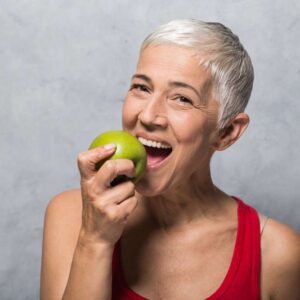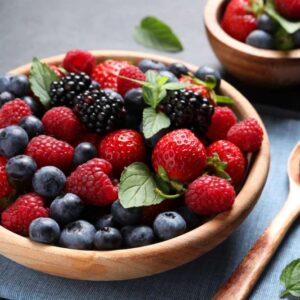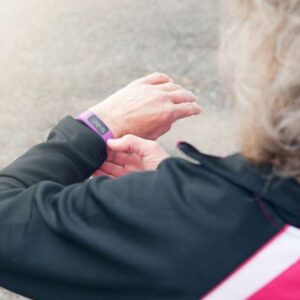
Solar-Powered Humans?
Every morning before work, I take a shot…
… of chlorophyll.
Yes, chlorophyll, the pigment found in plants that makes them so green and is responsible for converting sunlight into food.
I started doing this about five years ago when I realized the importance of maximizing phytonutrient intake, and I continue to do it because of the energy and skin benefits I get from it.
We’ve always known that green plants are good for us due to their vitamins, minerals, fiber, and phytonutrient content.
And I always assumed it was the micronutrients and phytonutrients in chlorophyll that helped increase my energy.
But I just stumbled upon a study that made me do a double take. The results from it indicated that chlorophyll may actually allow humans to harvest energy from the sun.
I’m not kidding!
Before we discover the details of this remarkable study, let’s take a refresher in Biology 101 and recall exactly how plants and animals produce energy.
In just about all life-forms, energy is stored in adenosine-5’-triphosphate (ATP) molecules. In humans and other animals, ATP is created in the mitochondria of our cells through the process of respiration. This process converts the nutrients we eat into cellular energy.
You probably recall hearing the mitochondria referred to as “the powerhouses” of the cell, because they are responsible for producing energy.
Plants, however, contain chlorophyll molecules that generate ATP by harvesting light.
OK, now on to the study.
First, researchers at the Columbia University Medical Center wanted to see if chlorophyll could actually get into mammalian cells. After feeding rats a chlorophyll-rich diet, they found that the rats had measureable levels of a metabolite of chlorophyll in their mitochondria. (1) This indicates that the plant pigments actually can get inside to the powerhouse of our cells.
Next, they fed the same chlorophyll metabolite to a group of special worms called C. elegans. The researchers were able to measure the ATP production of the worms and found that the group given the chlorophyll metabolite had a much greater increase in ATP production than the worms that did not. That means, the worms were actually able to create energy not with calories, but chlorophyll.
The chlorophyll metabolite also extended their life span.
The most striking thing about this study was that only when the worms fed chlorophyll were exposed to light was ATP production significant. When the chlorophyll metabolite-fed worms were in the dark, there was no increase in ATP.
In other words, the worms were able to harvest energy from light, just like plants.
And while this was in worms, C. elegans share many of the same essential biological characteristics as humans and are frequently used in scientific studies.
Other studies have confirmed this phenomenon and shown that mammalian cells are able to produce cellular energy directly through sun exposure. (2)
It does make me wonder…I always seem to have more energy in the summer even though I don’t eat as much food. Is the fact that we tend to eat ripe, chlorophyll-rich plants in the spring and summer months coupled with the ability to create energy from the sun the reason for this?
It’s interesting to consider.
But right now many of you are probably thinking: Well, that’s great and all, Jasmine, but HELLO! It’s WINTER! I’m not exactly able to go soak up the rays right now.
I hear you.
So is there any other reason to sling back shots of green juice every day, even during the winter?
Yup. Read on.
If you love grass-fed red meat as much as I do, you may want to consider taking a shot of chlorophyll (or eating some sautéed spinach) with your next steak or burger. That’s because chlorophyll could be crucial to help protect you against colon cancer.
According to the Linus Pauling Institute, chlorophyll is able to bind to certain carcinogens (like those found in cooked meat) and interfere with their absorption in the body. (3)
Chlorophyll and haem (a compound found in red meat) have similar molecular structures.
When eaten, haem is metabolized in the gut to a carcinogenic cytotoxic compound. This is why there has been an established association between red meat and colon cancer.
But in one animal study, when chlorophyll or chlorophyll-containing spinach was administered along with haem, they both completely inhibited the formation of the cytotoxic haem compound. (4)
So while there may be an association between red meat and colon cancer, there’s an even greater association between vegetables and protection against cancer. This may be one reason why.
If you don’t eat much red meat but you eat peanuts, legumes, or grains, you’ll want to consider this: Chlorophyll may also help protect against aflatoxin-induced liver cancer (5). Aflatoxin is a dangerous toxin commonly found on peanuts and moldy grains.
Regardless of exactly how they promote health, it undisputable that green, leafy plants and dark-colored fruits and vegetables are amazing for us and should form the basis of our daily diet.
And if you’ve ever done a shot of chlorophyll, juiced a bunch of green veggies, or mixed up a superfood drink mix that contains chlorophyll-rich ingredients, you know the amazing energy chlorophyll can give you.
While eating whole food is always best, if you want to significantly boost your daily intake of chlorophyll, you can buy it as a supplement and mix it in with your favorite drink or take it straight up in a shot glass.
I use World Organic Liquid Chlorophyll. Some brands (including this one) extract the chlorophyll from alfalfa, which has a genetically modified variety, so be sure to buy organic.
You can also look for a powdered superfood drink mix that includes ingredients like organic chlorella, organic kale, organic spinach, and organic parsley.
(One last tip: One researcher here at Living Well swears by chlorophyll to help cure a hangover. They shall remain unnamed.)
To living well,

Jasmine LeMaster
Health Researcher, Living Well
Sources
[1] Cheng X. Et al. Light-harvesting chlorophyll pigments enable mammalian mitochondria to capture photonic energy and produce ATP. J Cell Sci 2014 127: 388-399; doi: 10.1242/jcs.134262
[2] Herrera A.S. et al. Beyond mitochondria, what would be the energy source of the cell? Cent Nerv Syst Agents Med Chem. 2015;15(1):32-41. (PubMed)
[3] Dashwood R, Yamane S, Larsen R. Study of the forces of stabilizing complexes between chlorophylls and heterocyclic amine mutagens. Environ Mol Mutagen. 1996;27(3):211-218. (PubMed)
[4] De Vogel et al. Green vegetables, red meat and colon cancer: chlorophyll prevents the cytotoxic and hyperproliferative effects of haem in rat colon. Carcinogenesis. 2005 Feb;26(2):387-93. Epub 2004 Nov 18. (PubMed)
[5] Simonich MT, Egner PA, Roebuck BD, et al. Natural chlorophyll inhibits aflatoxin B1-induced multi-organ carcinogenesis in the rat. Carcinogenesis. 2007;28(6):1294-1302. (PubMed)
View More Free Articles
Four Carbs that Could Add YEARS to Your Life
You’ve likely been avoiding carbs like the plague. Health gurus, fitness influencers, and diet books have convinced you that carbs are the enemy—that they spike your blood sugar, pack on pounds, and fast-track you to diabetes. So you’ve eliminated bread, sworn off pasta, and feel guilty just touching a piece of fruit. But what if...
Upgrade from Bananas and Apples to These Powerhouse Fruits
I’m often asked which fruits are the best. So, let’s talk about it. I’ll cut right to the chase: berries win this contest hands down. If you’re limiting your options to apples and bananas, you’re missing out on a universe of superior antioxidant power. Those everyday fruits are like bringing a knife to a gunfight...
The REAL Reason Americans are Getting “Fatter”
You’ve heard it a thousand times: “Americans are getting fatter because we’re lazy.” We sit at desks all day. We binge-watch Netflix instead of hitting the gym. We’ve traded physical labor for sedentary lifestyles. It’s a tidy explanation for why obesity has skyrocketed in developed countries. There’s just one problem—it’s completely wrong… A groundbreaking Duke...
Mailbag: Room Won't Stop Spinning? Do THIS First
“I’m dealing with vertigo issues, lightheadedness, and dizziness. As recently as this last Saturday I had multiple occurrences throughout the day. Is there anything I can do for this? I’m 69 and in good health. I work out 4 to 5 times a week.” —Spinning Hi Spinning, When patients approach me with similar complaints, I...
Hidden Number Secretly Sabotages Male Performance
Guys (and gals that love them), we should talk. You know how we’ve always been told that bedroom troubles are just part of getting older—that we just need to live with them? Well, it turns out that’s not true. Scientists recently wrapped up a six-year study that followed over 100 healthy men, and the findings...
Shocking Study Links Kids' Snacks to Dangerous Early Puberty
Kids are growing up in a world vastly different from the one we knew. Back in our day, if a child wanted something sweet, it was a piece of candy or a homemade cookie. Today’s kids are surrounded by products filled with artificial sweeteners that didn’t even exist when we were raising our own children....
Outdated Vitamin Guidelines Put Your Brain at Risk
If you’re like most people, you probably don’t think twice about vitamin B12—until your doctor mentions it during a routine blood test. But new research published in the Annals of Neurology suggests we need to pay closer attention to this crucial nutrient—especially as we age. Turns out, current guidelines for this essential nutrient might be...
The TRUTH About Supplement "Liver Dangers" REVEALED
There’s been a lot of buzz lately about liver damage from supplements—so, let’s talk about it. Reports of supplement-induced liver injuries have some folks wondering, “Could my natural remedy actually be harming me?” But before you toss all your supplements in the trash, let’s separate fact from fear—and talk about how to use supplements safely....
The 10,000 Steps LIE That's Ruining Your Health
I’ll be honest—I’m a little sick of the 10,000-steps theory. You know, the one that insists you need to take at least that many steps daily to stay healthy? You won’t believe where that claim originally came from. The 10,000-steps theory wasn’t handed down from the fitness gods on stone tablets. It originated from a...
“Brain Games” Failed You? Try THIS For Better Memory Instead
You know all those brain-training apps, supplements, and “miracle” memory-boosters that promise to keep your brain sharp as you age? Here’s the truth… There IS evidence they support brain health—and that’s why I’ll be the first to recommend them. But they aren’t the most powerful brain-boosting tool available to you. Another surprising solution has earned...









